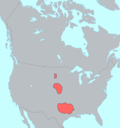Pawnee people

The Pawnee are a Native American Plains Indians tribe.[1] They lived mainly in what is now Nebraska and Kansas. Unlike other tribes of the Great Plains, they were semi-nomadic people.[1] They were hunters and farmers. The Pawnee farmed for most of the year and lived in earth lodges.[2] During the buffalo hunting season, they lived in tepees so they could follow the herds.[2] In the early 1800s their main village was on the south side of the Platte River (Nebraska). They raised crops including beans, corn, pumpkins, squashes and sunflowers.[2] The powerful Pawnee tribe had four individual bands. These were the Chaui (Grand), the Kitkehaki (Republican Pawnees), Pitahauerat (Tapage Pawnees) and the Skidi (Loup or Wolf Pawnees).[3] They were a fierce people who used war paint and tattoos to intimidate their enemies.[2] The Pawnee took scalps in battle. Pawnee war parties often rode out on scalping missions against other tribes.[4] The Pawnee also practiced human sacrifice.[5] Most often this took the form of ritually killing a young captive girl in a five-day ceremony.[5] She was sacrificed to the Morning Star. The last known ritual killing was of a girl in the mid-18th century.[3] The Pawnee were the largest tribe to have lived in Nebraska.[6] They were one of the earliest tribes to come to the area.[6] Estimates are that there were between 10,000 and 12,000 Pawnee in Nebraska by 1800.[6] They had little to fear from their enemies because they were a large tribe.[6] But smallpox and other diseases aswell as warfare with the Sioux reduced their numbers significantly in the early 1800s.[6] They were finally removed to Oklahoma in the 1870s.[4]
Pawnee People Media
Tribal territory of the Pawnee and tribes in Nebraska
Pawnee lodges near Genoa, Nebraska (1873)
Pawnee Indians migrating, by Alfred Jacob Miller
Ornamental hair comb by Bruce Caesar (Pawnee-Sac and Fox), 1984, of German silver, Oklahoma History Center
Miniature model of the Morning Star ritual, Field Museum
La-Roo-Chuck-A-La-Shar (Sun Chief) was a Pawnee chief who died fighting the Lakota at Massacre Canyon.
References
- ↑ 1.0 1.1 "Pawnee Indian Facts". Native American Indian Facts. Retrieved 15 June 2016.
- ↑ 2.0 2.1 2.2 2.3 Linda Alchin. "Pawnee Tribe". Native American Indian Tribes. Retrieved 15 June 2016.
- ↑ 3.0 3.1 "The Pawnee Indians - Farmers on the Plains". Legends of America. Retrieved 15 June 2016.
- ↑ 4.0 4.1 Mark van de Logt, '“The Powers of the Heavens Shall Eat of My Smoke”: The Significance of Scalping in Pawnee Warfare', Journal of Military History, Vol. 72, No. 1 (January 2008), p. 72
- ↑ 5.0 5.1 Ralph Linton, 'The Origin of the Skidi Pawnee Sacrifice to the Morning Star', American Anthropologist, Vol. 28, No. 3 (July-September, 1926), pp. 457–459
- ↑ 6.0 6.1 6.2 6.3 6.4 "The Pawnee". Nebraskastudies.org. Archived from the original on 11 December 2008. Retrieved 15 June 2016.







